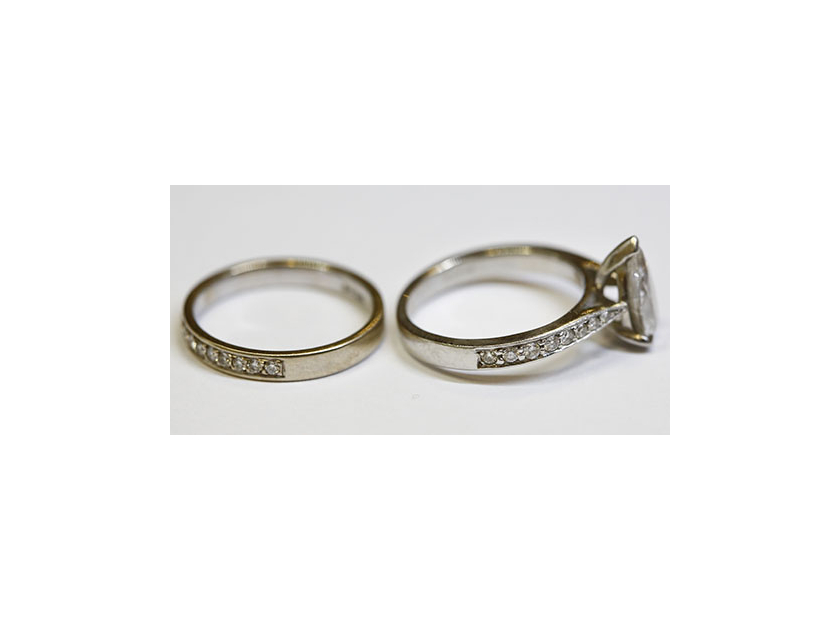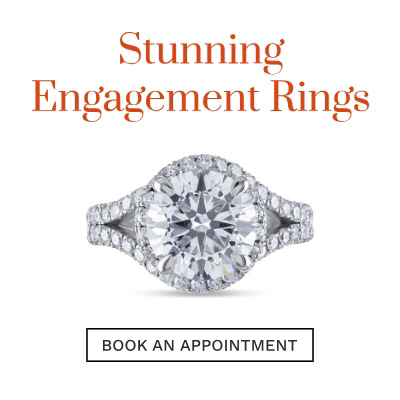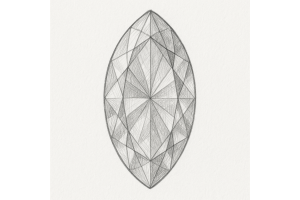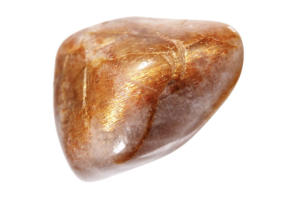GBP
/
GBP
/
Shipping to:
Currency:
Platinum vs. 18kt White Gold: Understanding the Differences
When choosing the perfect metal for your jewellery, especially for something as significant as an engagement ring or wedding band, it's essential to understand the differences between platinum and 18kt white gold. While both metals offer a stunning appearance, they differ in several key areas, including composition, durability, cost, and maintenance. This guide will delve deeper into these aspects to help you make an informed decision.
Composition and Appearance
Platinum is a naturally white metal, renowned for its purity. Jewellery made from platinum typically contains 95-98% pure platinum, with the remaining percentage comprising other alloys such as iridium or ruthenium. This high purity level gives platinum its unique, lustrous appearance and hypoallergenic properties, making it an excellent choice for those with sensitive skin.
In contrast, 18kt white gold is an alloy composed of 75% pure gold mixed with other white metals such as palladium, silver, or nickel to enhance its strength and whiteness. To achieve its bright white finish, 18kt white gold is often plated with rhodium, a metal from the platinum family. This plating gives white gold its characteristic shine and helps protect it from tarnish and wear.
Durability and Wear
One of the most significant differences between platinum and 18kt white gold is their durability. Platinum is a dense and robust metal, making it more resistant to wear and tear than white gold. Over time, platinum jewellery develops a patina, a natural satin finish that many people appreciate for its antique look. This patina can be polished away if a brighter finish is preferred, but it is also a testament to the metal's strength and longevity.
18kt white gold, while durable, is softer than platinum due to its gold content. This means it is more susceptible to scratches and may require more frequent maintenance, such as re-polishing or re-plating with rhodium, to maintain its appearance. However, the softness of white gold can also make it more malleable, allowing for intricate designs and detailing in jewellery.
Cost Considerations
Cost is often a significant factor when choosing between platinum and 18kt white gold. Platinum is generally more expensive than white gold due to its rarity and higher density. The additional weight of platinum also adds to the cost, particularly for larger pieces of jewellery. However, many people view platinum as a worthwhile investment because of its durability and lasting value.
18kt white gold is typically more affordable than platinum, making it an attractive option for those who want the look of platinum without the higher price tag. While white gold may require more maintenance over time, the initial savings can make it a more budget-friendly choice, especially for those seeking intricate or custom designs.
Maintenance and Care
Both platinum and 18kt white gold require some level of maintenance to keep them looking their best. Platinum's durability means it will retain its colour and finish for many years, even with daily wear. The patina that develops on platinum can be polished away by a jeweller if desired, but many people choose to keep it as a sign of the metal's authenticity and character.
18kt white gold, on the other hand, will need periodic re-plating with rhodium to maintain its bright white finish. Over time, the rhodium plating can wear off, revealing the slightly yellowish hue of the gold beneath. Regular cleaning and professional maintenance can help preserve the appearance of white gold jewellery, ensuring it remains as stunning as the day it was purchased.
Choosing the Right Metal for You
The choice between platinum and 18kt white gold ultimately comes down to personal preference, lifestyle, and budget. Platinum is ideal for those seeking a metal that is both durable and hypoallergenic, with a natural white sheen that will last a lifetime. On the other hand, 18kt white gold offers a beautiful and more affordable alternative, with the option to re-plate and maintain its appearance over time.
When making your decision, consider how you will wear your jewellery, how much maintenance you are willing to undertake, and how much you are prepared to invest in your piece. Both platinum and 18kt white gold offer unique advantages, and either can be the perfect choice depending on your individual needs and preferences.
Frequently Asked Questions (FAQ)
Is platinum more durable than 18kt white gold?
Yes, platinum is more durable than 18kt white gold. Platinum's density and strength make it more resistant to scratches and wear, which is why it is often chosen for engagement rings and wedding bands that will be worn daily. While 18kt white gold is also durable, it is softer than platinum and may require more frequent maintenance.
Does platinum scratch easily?
Platinum can develop scratches over time, but unlike white gold, the metal is not lost; it simply moves. This means that platinum jewellery can be polished to restore its original finish. The scratches on platinum are less noticeable than those on white gold, and many people appreciate the patina that platinum develops with age.
Why does 18kt white gold need to be re-plated?
18kt white gold is typically plated with rhodium to give it a bright white finish. Over time, this rhodium plating can wear off, revealing the natural yellowish tint of the underlying gold alloy. To maintain the white appearance of the jewellery, it is necessary to have it re-plated periodically by a jeweller.
Is platinum hypoallergenic?
Yes, platinum is a hypoallergenic metal, which means it is unlikely to cause allergic reactions. This makes it an excellent choice for individuals with sensitive skin or metal allergies. In contrast, some white gold alloys may contain nickel, which can cause reactions in those with nickel allergies.
Which metal is better for intricate jewellery designs?
18kt white gold is generally better suited for intricate jewellery designs due to its malleability. The softness of gold allows jewellers to create detailed and complex patterns more easily than with platinum. However, both metals can be used to create beautiful, custom designs depending on your preferences.
Is platinum worth the extra cost?
Platinum's higher cost reflects its rarity, density, and durability. While it is more expensive than 18kt white gold, many consider it a worthwhile investment due to its lasting value and low maintenance. Platinum jewellery retains its white colour without the need for re-plating, and its strength ensures it will stand the test of time.









